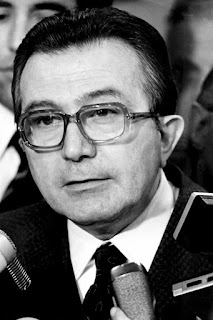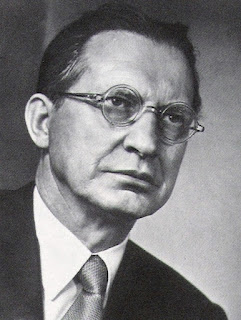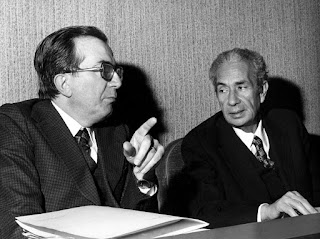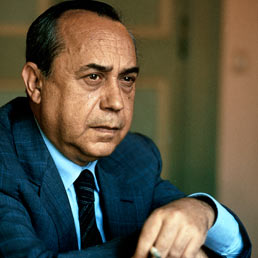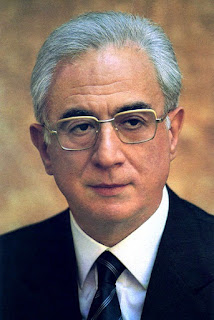Well-connected Cosa Nostra boss had links to ex-premier Andreotti
 |
| Stefano Bontade, head of major crime family in Palermo |
Stefano Bontade, one of the most powerful and well connected
figures in the Sicilian Mafia in the 1960s and 1970s, was born on this day in
1939 in Palermo, where he was murdered exactly 42 years later in a birthday execution
that sparked a two-year war between the island’s rival clans.
Known as Il Falco – the Falcon – he was said to have close
links with a number of important politicians on Sicily and with the former
Italian prime minister Giulio Andreotti.
He was strongly suspected of being a key figure in the 1962
murder of Enrico Mattei, the president of Italy’s state-owned oil and gas
conglomerate ENI, and in the bogus kidnapping of Michele Sindona, the disgraced
banker who used the Vatican Bank to launder the proceeds of Cosa Nostra heroin
trafficking.
Born into a Mafia family, Bontade controlled the Villagrazia
area in the south-west of Palermo and became head of the Santa Maria di Gesù
crime family at the age of 25 when his father, Francesco Paolo Bontade, a major
Cosa Nostra boss known as Don Paolino, stepped down in failing health.
He was banished to the mainland, specifically Qualiano in
Campania, following his arrest in 1972 after Pietro Scaglione, the chief
prosecutor of Palermo, had been murdered.
A sustained crackdown on Mafia activity following the Ciaculli Massacre
of 1963 had achieved significant progress in cutting off the organisation’s
income streams but, ironically, the banishment of bosses in Bontade’s
generation backfired on the authorities.
Along with others, Bontade made new contacts with Mafiosi on
the mainland and their involvement in cigarette smuggling and heroin
trafficking enabled them to rebuild their powerbase in Sicily. Bontade became part of a network involved
with the processing and trafficking of heroin from Turkey to the streets of cities
in the United States, where it was distributed by the Gambino family.
 |
| Gambino family boss Carlo Gambino |
Bontade’s links with Cosa Nostra figures in the US were
seemingly behind his alleged organising of the Mattei killing, supposedly
requested by a Sicilian-born Mafioso from Philadelphia because
Mattei’s policies threatened the profitability of the United States oil industry,
in which the American Mafia had vested interests.
Later, the Gambino family enlisted his help in a scheme
proposed by Sindona to recover a Cosa Nostra fortune that had been lost when
the Franklin National Bank in Long Island, which Sindona controlled and through
which much of the laundered heroin proceeds were laundered, collapsed in 1974.
Sindona was in the US awaiting trail on fraud charges
connected with the collapse, while being also wanted in Italy in connection
with the murder of a police superintendent and a lawyer who were investigating
of his failed Banca Privata Italiana.
In what appeared to be a kidnap, he was smuggled out of the US and back to Sicily, where he attempted to blackmail former political
allies, including Andreotti, in return for the re-establishment of his banking
empire and the recovery of Mafia money.
The plot failed and Sindona was returned to America, where he died in
prison, apparently through poisoning, shortly after he was convicted for the
murder of the Sicilian lawyer, Giorgio Ambrosoli.
 |
| Three times PM Giulio Andreotti |
Bontade, a freemason, cultivated a network of connections that included
Christian Democrat politicians in Sicily, through whom links could be traced
right to the top of Italian politics and to Andreotti, who was prime minister
twice in the 1970s and again from 1989-92.
Andreotti is said to have appealed directly to Bontade in a
bid to prevent the murder of Christian Democrat politician Piersanti
Mattarella, who became a target after promising to smash the Mafia’s public contracts
racket on Sicily. According to the evidence of a Mafia pentito, Francesco
Marino Mannoia, Bontade threatened Andreotti with wiping out all of his party’s
representatives in Sicily unless his demands were met and the Mattarella
killing went ahead.
Bontade’s own death in 1981 came after Salvatore Riina, the
most powerful figure in the Corleonesi clan from inland Sicily, formed a secret
alliance with the Palermo mafioso and Bontade adversary Michele Greco with the
aim of seizing control of the heroin trafficking operation. Riina and Bontade were supposed to be allies as members of the Sicilian Mafia Commission, on which Greco eventually replaced a Bontade ally, Gaetano Badalamenti.
 |
| Giovanni Falcone and Paolo Borsellino |
Riina and Greco organised the killing of many of Bontade’s friends
and associates and tipped off police to arrest others, especially those
involved directly with the trafficking network.
Bontade himself was murdered as he drove home from a party to celebrate
his 42nd birthday, the execution carried out with a Kalashnikov
machine gun by Pino Greco, Michele's nephew and a favoured Riina hitman.
Subsequently, two Bontade allies, Tommaso Buscetta and
Salvatore Contorno, became pentiti, and it was largely their evidence that
enabled the anti-Mafia magistrates, Giovanni Falcone and Paolo Borsellino to
convict 360 Cosa Nostra members in the mid-1980s in the so-called Maxi Trial. Those sent to jail included Greco
and Riina, although Riina later exacted revenge by ordering the murders of both
Falcone and Borsellino in 1992.
 |
| The convent of San Benedetto il Moro |
Travel tip:
Santa Maria de Gesù, which gave its name to the area of
Palermo Bontade controlled at the height of his powers, is actually a village at
the foot of Monte Grifone, the 832m (2,730ft) peak that forms part of the Monti di
Palermo chain and was once home to a colony of griffon vultures. Panoramic
views of the city can be obtained from the Convent of San Benedetto il Moro,
the patron saint of Palermo, who died at Santa Maria de Gesù in 1589. In the
highest part of town is the tree of San Benedetto, a 500-year-old cypress that
according to legend was planted by the saint himself.
 |
| The golden mosaics of the Cappella Palatina |
Travel tip:
By common consensus, if there is one attraction visitors to
Palermo should not miss it is the Cappella Palatina, the extraordinary chapel
that occupies the middle level of the three-tiered loggia of the Palazzo dei
Normanni in Piazza Indipendenza. Almost every inch of the inside of the chapel
is decorated with gold mosaics and inlaid precious stones. The chapel was built
by Roger II, the King of Sicily, who hired Byzantine Greek artisans to work on
the project in about 1140. The marble floor and walls reflect Islamic
influences.
How Giulio Andreotti, the great survivor, spent 45 years in government
The anti-Mafia crusade of Giovanni Falcone
A life of corruption and fraud: the failed banker Michele Sindona
Also on this day:
1857: The birth of opera composer Ruggero Leoncavallo
1964: The birth of conductor Gianandrea Noseda
More reading:
How Giulio Andreotti, the great survivor, spent 45 years in government
The anti-Mafia crusade of Giovanni Falcone
A life of corruption and fraud: the failed banker Michele Sindona
Also on this day:
1857: The birth of opera composer Ruggero Leoncavallo
1964: The birth of conductor Gianandrea Noseda
